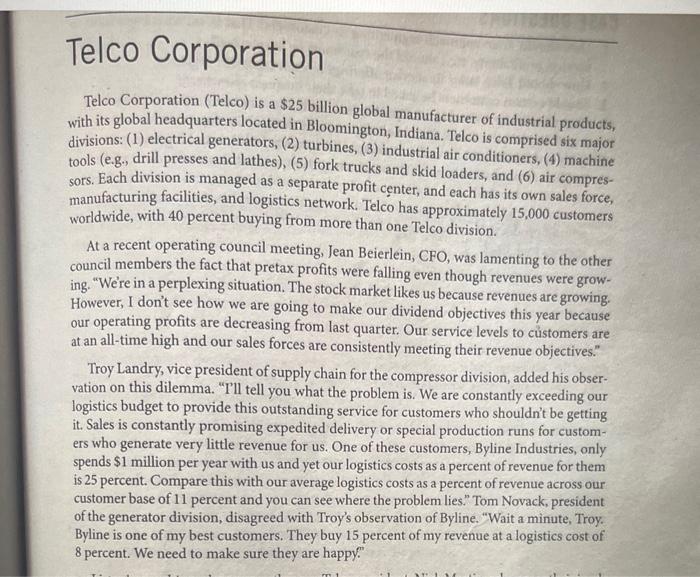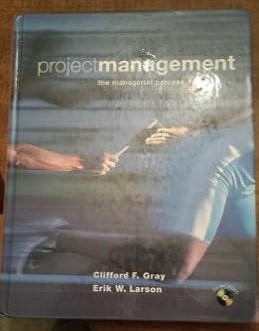What are the main issues identified in the case?
Telco Corporation (Telco) is a $25 billion global manufacturer of industrial products, with its global headquarters located in Bloomington, Indiana. Telco is comprised six major divisions: (1) electrical generators, (2) turbines, (3) industrial air conditioners, (4) machine tools (e.g., drill presses and lathes), (5) fork trucks and skid loaders, and (6) air compressors. Each division is managed as a separate profit center, and each has its own sales force, manufacturing facilities, and logistics network. Telco has approximately 15,000 customers worldwide, with 40 percent buying from more than one Telco division. At a recent operating council meeting, Jean Beierlein, CFO, was lamenting to the other council members the fact that pretax profits were falling even though revenues were growing. "We're in a perplexing situation. The stock market likes us because revenues are growing. However, I don't see how we are going to make our dividend objectives this year because our operating profits are decreasing from last quarter. Our service levels to customers are at an all-time high and our sales forces are consistently meeting their revenue objectives." Troy Landry, vice president of supply chain for the compressor division, added his observation on this dilemma. "Ill tell you what the problem is. We are constantly exceeding our logistics budget to provide this outstanding service for customers who shouldn't be getting it. Sales is constantly promising expedited delivery or special production runs for customers who generate very little revenue for us. One of these customers, Byline Industries, only spends $1 million per year with us and yet our logistics costs as a percent of revenue for them is 25 percent. Compare this with our average logistics costs as a percent of revenue across our customer base of 11 percent and you can see where the problem lies." Tom Novack, president of the generator division, disagreed with Troy's observation of Byline. "Wait a minute, Troy. Byline is one of my best customers. They buy 15 percent of my revenue at a logistics cost of 8 percent. We need to make sure they are happy." Listening to this exchange was the new Telco president, Nick Martin, who recently joined Telco after spending 15 years as COO of a global agricultural products manufacturer. This problem was not new to Nick. His former employer was also structured across business lines with common customers across the globe and found that a similar service strategy for all customers was not a viable alternative. Nick added, "I've seen this before. The problem is that we are treating all customers alike and we are not taking into consideration those customers who buy from more than one division. Before the meeting, I asked Jean to run some profitability numbers across our customer base. The results are amazing. Thirty-three percent of all of our customers account for 71 percent of our operating profits. Another 27 percent account for approximately $100 million in losses. Obviously, we have some customers who are more profitable than others. We need to develop a strategy to segment our customers and offer each segment the suite of services they are willing to pay for." "Wait a minute," exclaimed Chris Sills, vice president of corporate sales. "You're asking us to take some services away from our customers. Who is going to break the news? What about the sales commissions for my reps? This is not going to be received well by the customer base." You have been hired as an expert on customer relationship management. Telco's current service offerings to its entire customer base include product quality, order fill rates, lead time, delivery time, payment terms, and customer service support. You have been asked to prepare a report outlining how Telco could adopt the CRM approach to its customers. Specifically, this report should address the following case questions








